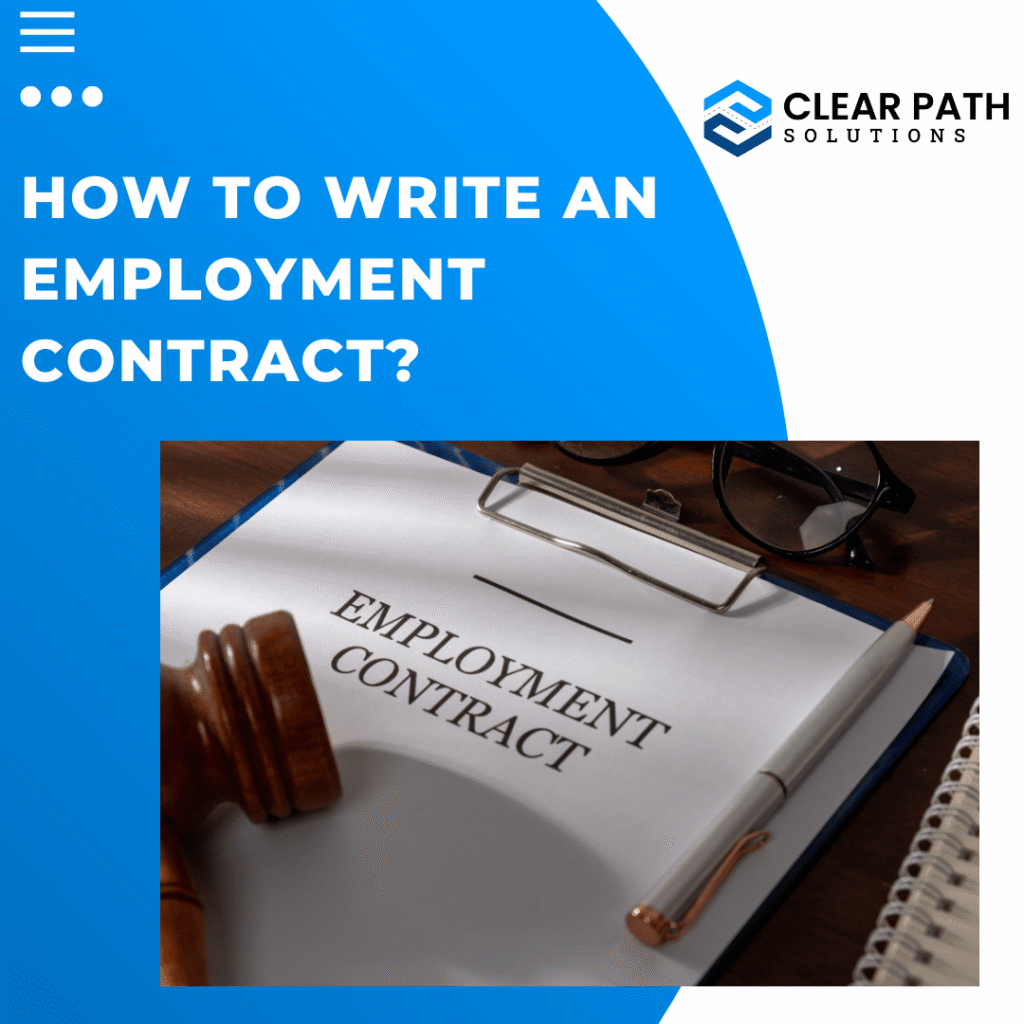An employment contract is one of the most important documents in any workplace. It not only sets out the rights and responsibilities of both employer and employee but also provides legal protection in case of disputes.
If you run a business in the UK, it’s essential to understand how to write an employment contract that’s clear, compliant, and tailored to your organisation’s needs. In this blog post guide, we’ll break down the essentials of drafting an effective employment contract, from legal requirements to best practices.
What Is an Employment Contract?
An employment contract is a legally binding agreement between an employer and an employee that outlines the terms and conditions of employment.
In the UK, the law requires employers to give most employees a written statement of employment particulars on or before their first day of work (as per the Employment Rights Act 1996). While the written statement isn’t always the full contract, it forms a core part of it.
Why an Employment Contract Is Important?
A well-drafted contract:
- Clarifies expectations for both parties
- Prevents disputes by setting clear boundaries
- Protects the business legally and financially
- Supports compliance with UK employment laws
- Builds trust with employees
Failing to provide a proper contract can lead to penalties, employment tribunal claims, and reputational damage.
Additionally, the employment contract acts as a vital document that safeguards the interests of both employer and employee. For employers, it establishes clear expectations, responsibilities, and legal protections, helping to avoid disputes and ensuring smooth workforce management. For employees, it provides job security, clarity on roles, salary, benefits, and working conditions, protecting them from unfair practices. By outlining terms such as notice periods, confidentiality, and dispute resolution, it reduces misunderstandings and builds mutual trust. In essence, an employment contract creates a transparent, professional foundation, fostering accountability and stability in the workplace while ensuring compliance with labor laws.
Legal Requirements for Employment Contracts in the UK
When writing an employment contract, you must ensure it complies with UK employment law. Here are some minimum legal requirements for written statements of particulars:
- Names of employer and employee
- Job title or brief description of the role
- Start date of employment
- Pay (amount, method, frequency)
- Hours of work (including overtime and flexible arrangements)
- Holiday entitlement (including public holidays)
- Place of work and whether remote working is allowed
- Notice period for ending the employment
- Sick pay and procedures
- Pension details
- Disciplinary and grievance procedures
For employees working abroad or on fixed-term contracts, additional clauses may be needed.
Types of Employment Contracts in the UK
Before writing a contract, decide which type suits the role:
- Permanent contracts – Full-time or part-time, ongoing employment
- Fixed-term contracts – Employment for a set duration or until project completion
- Zero-hours contracts – No guaranteed hours, work offered as needed
- Freelance or contractor agreements – non-employment relationship
The type of contract affects rights and obligations, so ensure it’s appropriate for the situation.
Step-by-Step Guide to Writing an Employment Contract
- Start with the Basics: Begin by clearly identifying the employer and the employee, including their legal names and addresses. This prevents confusion and ensures the contract is tied to the correct parties.
- Define the Job Role: Specify the job title and a brief description of the role. Avoid vague language – clarity here helps manage expectations.
Example: “The Employee will work as a Marketing Coordinator, responsible for social media campaigns, content creation, and supporting the marketing team with promotional activities.”
- Outline the Start Date and Duration: Include the start date and, if applicable, the end date for fixed-term roles. Mention any probationary period and how performance will be reviewed.
- Detail Pay and Benefits: State the salary or hourly rate, how it’s calculated, and payment frequency (e.g., monthly in arrears). Include any bonuses, commission schemes, or allowances.
Example: “The Employee will be paid £30,000 per annum, payable monthly in arrears by bank transfer on the last working day of each month.”
- Specify Working Hours and Location: Outline standard working hours, overtime arrangements, and flexibility. If hybrid or remote work applies, set clear expectations.
Example: “The Employee will work 37.5 hours per week, Monday to Friday, from 9:00 am to 5:30 pm, at the company’s London office, with the option to work from home up to two days per week.”
- State Holiday Entitlement: Specify the number of paid holiday days, including whether public holidays are included or extra. Include how unused leave is handled.
- Include Sick Pay and Procedures: Outline statutory and contractual sick pay provisions and reporting requirements for illness.
- Explain Notice Periods: Set out how much notice each party must give to terminate employment. This is crucial for business continuity and legal compliance.
- Add Confidentiality and Restrictive Covenants: Protect your business by including clauses on:
- Confidential information
- Non-compete clauses (where reasonable)
- Non-solicitation of clients or staff
Ensure these are fair and legally enforceable.
- Address Disciplinary and Grievance Procedures: Refer to your company’s policies and where they can be found, ensuring compliance with the ACAS Code of Practice.
- Include Statutory Provisions: Reference statutory rights, such as maternity/paternity leave, redundancy procedures, and equal opportunity policies.
- Make Allowances for Flexibility: If business needs may change, include clauses that allow reasonable variation of duties or work location (within legal limits).
Best Practices for Drafting Employment Contracts
- Use plain English – Avoid overly legalistic language to ensure employees understand their rights and duties.
- Be specific – Ambiguity can lead to disputes.
- Keep it updated – Review contracts regularly to reflect changes in law and business operations.
- Ensure fairness – Unreasonable terms may be unenforceable and harm employee relations.
- Seek legal advice – Especially for senior roles or complex arrangements.
Common Mistakes to Avoid
Using generic templates without customisation – Every role and business is different. Generic templates without customization may also fail to address specific job roles, company policies, and legal requirements. This can lead to loopholes, disputes, and non-compliance with labor laws. A tailored contract ensures clarity, protects both parties, and reflects the unique needs of the employment relationship.
Leaving out mandatory details – This can lead to legal breaches, confusion, and disputes. Missing elements like job role, salary, benefits, or termination clauses weaken enforceability and may expose employers to risks. Comprehensive contracts ensure compliance with labor laws, protect employee rights, and provide clarity for both parties.
Failing to update contracts – Laws change; so should your contracts. Regularly revising contracts ensures they reflect current obligations, protect both parties, and maintain transparency, fostering trust and reducing risks in the employment relationship.
Overly restrictive clauses – Courts may strike these down as such clauses can discourage talent, limit employee growth, and may be legally unenforceable. A balanced agreements protect employer interests while ensuring fairness, fostering positive workplace relations, and reducing the risk of disputes or contract challenges.
Not providing contracts on time – This is a legal requirement in the UK. Without timely agreements, disputes over salary, roles, or policies may arise. Prompt issuance ensures legal compliance, clarity of expectations, and establishes a professional foundation for a secure working relationship.
On a Concluding Note,
A well-drafted Employment contract helps avoid misunderstandings, strengthens trust, and ensures compliance with labor laws. By setting expectations upfront, it creates a balanced framework where both parties feel protected and accountable, fostering long-term stability, productivity, and a healthy employer-employee relationship.
**********************************************
How Clear Path Solutions assists it s Clients to take care of everything related to Employment Contracts
- Many small and medium-sized businesses in the UK struggle to keep up with changing employment laws and best practices. At Clear Path , Our team of Experts is always there to help you by:
- Drafting legally compliant employment contracts tailored to your industry
- Updating contracts as and when laws change
- Providing advice on complex clauses such as restrictive covenants
- Managing contract disputes and employee queries
- Ensuring your documentation aligns with your wider HR policies
By outsourcing your HR tasks, you save time, reduce legal risks, and ensure your contracts protect both your business and your employees.
We understand that writing the perfect employment contract can be daunting.
No worries!
Our team of HR and employment law specialists will draft, review, and maintain your contracts so you can focus on growing your business.
Let us protect your business and your employees – contact Us today for a free consultation.
📞 Call us at [020 377 30992]
📧 Email: [ sales@clearpathuk.co.uk]





